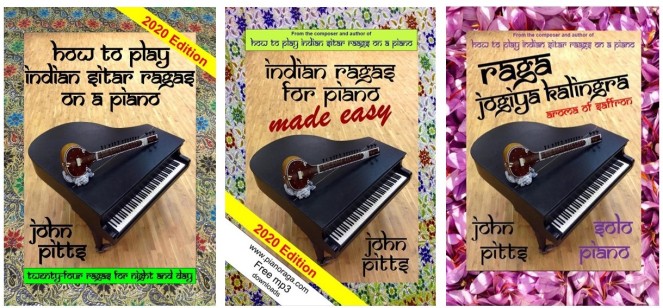[New books—December 2021 Extreme Heterophony: a study in Javanese Gamelan for one or more pianists read more here, December 2022 SAKURA Three Koto Transcriptions for solo piano read more here]
- Amazon UK / USA – How to Play Indian Sitar Rāgas on a Piano (2016, fully revised 2020) Perfect-bound, 268 pages, 21 x 1.5 x 29.7 cm. The 2020 edition is also available coil-bound from Lulu or as a digital download from SheetMusicPlus or BUY NOW in any format from this website
- Amazon UK / USA – Indian Rāgas for Piano Made Easy (2018, 2020) or BUY NOW from this website
- Amazon UK / USA – Rāga Jogiya Kalingra “Aroma of Saffron” (Christmas 2019)

How to Play Indian Sitar Rāgas on a Piano (2016, 2020)

262-page book by composer John Pitts, with sheet music for 24 rāgas, step by step instructions and hundreds of musical examples to try out.
2nd edition – fully revised 2020 (first published 2016).
Indian rāgas (or raags) have an extraordinary musical heritage dating back several centuries (from the area that is now India, Pakistan and Bangladesh) – a truly unique musical genre of fascinating melodic beauty and rhythmic intricacy – freely combining elaborate composed melodies with carefully rehearsed improvisation. This rich and intriguing music is traditionally performed on sitar – or instruments such as the sarangi, sarod, esraj or voice – and has previously been generally unavailable to pianists.
But now the amazing world of Indian rāgas has been opened up in this sympathetic but thorough reinvention for piano solo (or duet or two pianos) by an award-winning British composer (www.johnpitts.co.uk). Watch video samples from the book.
This collection of 24 rāgas will be enjoyed by good amateur pianists through to virtuosic professionals. It is suitable for any pianist who enjoys discovering new music, or who has an interest in music from other cultures, or who knows the pleasure of jazz noodling and wants to explore a rewarding and fresh (but centuries-old) form of improvisation.
This book contains:
- Sheet music for piano solo: a set of 24 rāgas, newly composed within a traditional rāga genre, one for each hour of night and day, sunset to sunset, encompassing a wide array of moods, and based on over twenty fascinating scales.
- Step by step instructions to play each of the pre-composed and improvised sections of Indian rāgas, written for pianists who are used to playing European classical music and jazz. This includes how to develop the melodic material in the improvised ālāp (with optional joṛ and jhālā sections), and the part composed part improvised slow, medium and fast gat sections, with optional jhālā to finish.
- Instructions to play any of these rāgas in a duet or at two pianos.
- Hundreds of musical examples.
- Accompanying audio & video examples can be accessed for free at pianoraga.com
The book has been fully revised in 2020, with improved explanations and definitions, spellings conformed to academic usage, corrected inclusion of the improvised joṛ section, inclusion of mohrā phrases in the ālāp, and a transcription of the intricate free-pulse rhythms in the first example ālāp video. Read more here...
Indian Rāgas for Piano Made Easy (2018, 2020)

Second Edition Published January 2020 (First edition 9Jan2018), Intensely Pleasant Music
This book is a collection of eight Indian rāgas, re-imagined for piano, and simplified for fledgling pianists (both children and adults). The purpose is to provide an introductory experience of classical Indian music-making in an easy, hands-on way at a piano, offering a very accessible first encounter with improvisation. It is designed for near-beginners (pre-grade 1) through to early intermediate players, and can be used as a stepping stone to the much bigger volume for more advanced pianists: How to Play Indian Sitar Rāgas on a Piano (Intensely Pleasant Music, 2016/2020).
The first three rāgas are each presented in three versions – “really easy”, “easy” and “quite easy/not so easy” – so that students and their teachers can quickly find a best fit for their level, and add complexity when ready. Read more…
Click here to download a free zip file containing all the mp3s. Or, click here for the links to download individual mp3 recordings of each rāga.
Rāga Jogiya Kalingra “Aroma of Saffron” (Christmas 2019)

The word rāga literally means ‘to colour’, and from that also ‘to induce passion’ or ‘emotion’. The musical term rāga refers to a performance, within the melodic and structural conventions of Indian classical music, that evokes a particular emotion. Rāga Jogiya Kalingra “Aroma of Saffron” evokes a mood of wonder:
It is night-time. Strong breezes blow through purple fields of the beautiful saffron flower, its red stigma the source of the world’s most expensive spice, releasing wafts of powerful fragrance.
This through-composed Rāga Jogiya Kalingra “Aroma of Saffron” is a solo performance piece for piano lasting around 16 minutes. It is a fully fleshed-out version of the musical material from the 12th rāga/raag in the book How to Play Indian Sitar Raags on a Piano (2016) by British composer John Pitts, and is suitable for advanced pianists.
Indian rāgas have an extraordinary musical heritage dating back several centuries (from the area that is now India, Pakistan and Bangladesh) – a truly unique musical genre of fascinating melodic beauty and rhythmic intricacy – freely combining elaborate composed melodies with carefully rehearsed improvisation.
With improvisation being such an important element in the performance of Indian rāgas, sheet music of a through-composed and fully-notated rāga may seem like a contradiction in terms. However, this piece, with its notated sections of ‘improvisation’, is designed to serve two purposes: 1) as a model example of how to follow the ample instructions in rāga improvisation for owners of copies of How to Play Indian Sitar Raags on a Piano; and 2) simply as a performance piece in its own right for classical pianists who are used to playing entirely from written music.